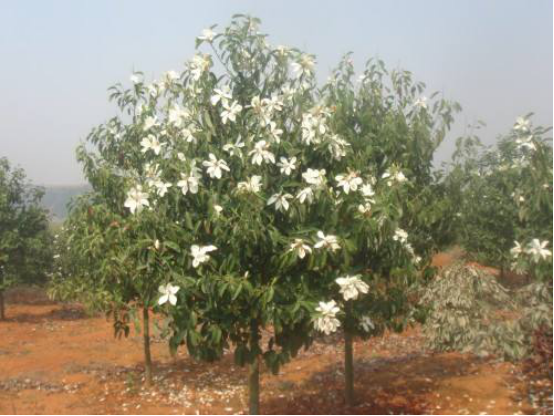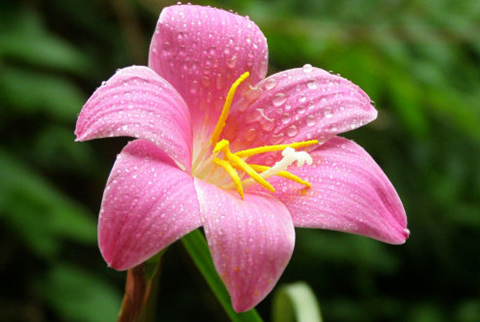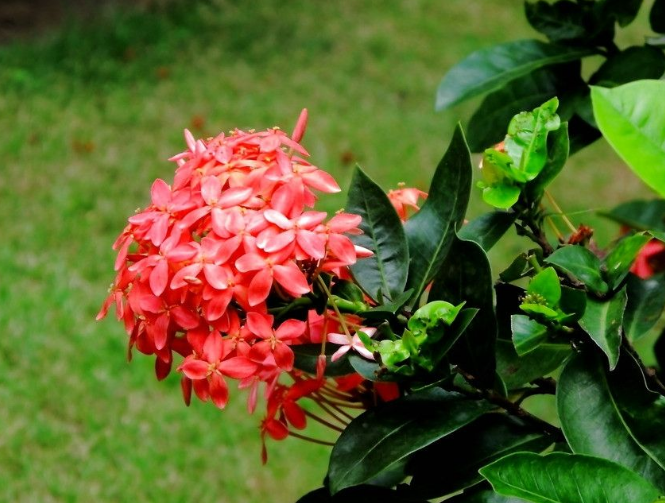Disease and insect control of Michelia mollissima at seedling stage
1. Root rot, stem rot, anthrax
When the above diseases are found, the disease vaccine should be removed and burned in time, sprayed with 1% Mel 3% ferrous sulfate solution every 4-6 days for 2-4 times, and soil disinfection with 50% carbendazim 15kg/667m2 or 50% carbendazim 1kg/667m2 or 50% carbendazim 0.125% solution spray control.
2. Grub, ground tiger
Grubs, ground tigers and other underground pests: will bite the roots of seedlings for food, easy to cause seedling death, can be combined with the rainy season to do a good job of ditch drainage, and with 90% trichlorfon and marathon emulsion 0.1% solution, with bamboo sticks in the seedling bed hole irrigation, the effect is better.

All right, that's all for today's content introduction. If you want to pay more attention to the smiling information in the mountains, please collect and share our four Seasons Plant Internet cafes.
The method of sowing and propagation of Michelia mollissima
Soil selection
Michelia mollissima is a shallow-rooted tree species, so we should choose sandy soil with deep and fertile layer, adequate water supply and good drainage.
The application of base fertilizer in the soil and the disinfection and control of soil with chemical solution can effectively reduce the incidence of underground pests.
Selection of species
The seeds of Michelia mollissima can be sown at any time, and it is easy to reproduce. But we still need to sow seeds seriously if we want to get a good adult Michelia mollissima.
Spring and March is a good time to sow seeds. The seeds can be soaked in 0.5% potassium permanganate solution for 2 hours before sowing, and then placed in warm water for 24 hours. This step is to promote germination.
After the seeds are absorbed and expanded, the seeds are taken out and dried, and then the seeds can be mixed with calcium magnesium phosphorus fertilizer to increase the nutrients of the plant.
Sowing period
When sowing, bury the seeds in the soil about 1mm, then cover the surface of the seeds with coke ash, about 1cm thick. Then cover the seeds completely with loess.
After sowing, it is necessary to cover the grass, which is conducive to keeping the soil loose, ensuring a certain amount of humidity, and is conducive to the successful germination of seeds.
Later maintenance and management
About a month after sowing, the seeds can basically break the soil and germinate. At this time, you can remove the "coat" of the wolf grass.
The seedlings of Michelia mollissima are fragile and vulnerable to various insect pests. Therefore, at this stage, we should pay attention to the prevention and control of diseases and insect pests. For specific prevention and control methods, you can refer to our previous articles!
Seedling cultivation technology of MichliamaudiaeDunn. , alias Magnolia officinalis, Magnolia glauca, Michelia mollissima, is a tall evergreen tree of Magnoliaceae. This tree species has the advantages of fast growth, good material, strong adaptability, easy reproduction and less diseases and insect pests. It is not only a fast-growing evergreen broad-leaved timber species, but also an excellent local tree species in our province. It has dense branches and leaves, green in winter, beautiful tree shape, white flowers in early spring, large flowers and fragrance, and has high ornamental value and economic value. it is an excellent tree species for garden greening and side greening. In order to meet the needs of forest species, tree species structure adjustment and urban and rural beautification, we studied the seedling growth rhythm and seedling raising techniques of Michelia mollissima.
1 observation of growth rhythm at seedling stage
667 m 2 of Michelia mollissima was cultivated in this experiment, which was sown on November 23, 2000 and emerged on April 5, 2001. The sample of 1m 2 was selected to measure the seedling height and ground diameter one by one on the 20th of each month. After one year of cultivation, 15200 seedlings were produced, with an average seedling height 53cm and an average ground diameter 0.90cm. The results of observation showed that the growth rules of ground diameter and seedling height of Michelia mollissima were basically the same, that is, from slow → growth to medium → growth, rapid → growth stopped. Generally speaking, the growth is slow from April to June, moderate in July, the fastest from August to October, and slow and stopped from November to December. Mastering this growth law provides a scientific basis for the formulation of appropriate time, times and quantity of interseedling and topdressing.
2 Seedling technology
2.1 nursery site selection
Michelia mollissima is a shallow-rooted tree species, and the nursery should choose sandy loam with good drainage and irrigation conditions, moderate sunlight, deep soil layer, fertile soil, sufficient water source and good drainage.
2.2 nursery bed production
Before sowing, the nursery should be turned over deeply, and the soil preparation should be meticulous, so as to achieve "three ploughing and three harrowing". At the same time, 70% thiophanate 5kg was used for soil disinfection and 90% trichlorfon 2kg was applied for soil disinfestation. 2500kg was applied every 667m 2, and 70% thiophanate 5kg was used for soil disinfection and 90% trichlorfon 2kg for soil control. After soil disinfection, the bed was built with the height of 25cm, the width of 110~120cm and the width of walking ditch 30~35cm. Bed with tortoise back shape, all around a good drainage ditch, edge ditch deep, in the ditch shallow, so that the rain stop ditch does not accumulate water.
2.3 sowing
Seeds can be sowed with picking or stored in wet sand until late February to early March in early spring. In order to improve the germination rate of seeds and reduce the trouble of seed sand storage, the seeds can be sown directly after being shaded and dried. Before sowing, soak the seeds with 0.5% potassium permanganate solution for 2 hours, put them into warm water to promote germination for 24 hours, wait for the seeds to absorb water and expand, remove the seeds and place them in the bamboo basket to dry. The seeds were mixed with calcium magnesium phosphate fertilizer after drying.
Using strip sowing, strip spacing 25cm, sowing rate 8~10kg/667m 2. Sowing ditch deep 1.5~2cm, after sowing, cover the seeds with charred plaster, the thickness is about 1cm, and then cover the yellow core soil 1~2cm. In order to keep the seedling soil loose and moist, and conducive to seed germination, it is necessary to cover the grass, and its thickness is not seen in the soil. After sowing, it is necessary to strengthen the field management of the nursery, in addition to spreading poisonous rats on the walkway and around, timely do a good job of clearing ditches and draining in rainy days and watering and moisturizing in dry weather.
2.4Seedling management
In early April, when the average temperature was about 15 ℃, the seeds began to break the soil and germinate. When 70% 80% of the seedlings were unearthed, the grass could be removed in cloudy or sunny evenings. On the 2nd day after uncovering the grass, 70% methyl thiophanate 0.125% solution and 0.5% equivalent Bordeaux solution were sprayed alternately for 2 times to prevent the occurrence of diseases.
In the early growth stage of Michelia mollissima (from April to mid-June), the high growth accounted for 13.6% of the annual growth, and the seedlings grew slowly and had poor stress resistance, so weeding, loosening soil and proper fertilization should be done well. Rarefied human feces and urine with a concentration of 3% to 5% and 2% cooked cake fertilizer were applied every 10 to 15 days from late April to late May. After June, 0.2% compound fertilizer was used to irrigate around the roots of the seedlings, and the solution should not be poured on the leaves as far as possible.
In order to improve the quality of seedlings, accelerate the growth of seedlings and control the density of seedlings reasonably, the overdense seedlings should be removed in time in the overcast and rainy weather in May, and the seedlings should be interplanted in camphor trees. The three-dimensional cultivation experiment showed that the row spacing was 10cm × 20cm, and the seedling height and ground diameter were good, and good results were obtained. The seedlings were fixed in the first ten days of July, leaving 3035 seedlings per square meter.
From late April to early July, seedlings are susceptible to root rot, stem rot and anthracnose. The diseased seedlings should be pulled out in time and burned, sprayed with 1%-3% ferrous sulfate solution every 4 days for 2 times, and soil disinfection with quicklime 15kg/667m 2 or 50% carbendazim 1kg/667m 2 or 50% carbendazim 0.1 ~ 0.125% solution spray control. From late April to mid-May, it is easy to be gnawed by grubs, ground tigers and other underground pests on the roots and stems of seedlings, which is easy to cause seedling death. It can be combined with the rainy season to do a good job of ditch cleaning and drainage, and 0.1% solution of 90% trichlorfon and marathon emulsion is used to irrigate the seedling bed with bamboo sticks, and the effect is better. It is easy to be infected with shell insects from May to June. When the population density of shell insects on leaves is too high, spray with 50% marathon, 40% dimethoate 0.1% solution or 25% imidophos 0.125% solution. The peak growth period was from late June to mid-October, and its height and diameter growth accounted for 68.9% and 60.0% of the annual growth, respectively. . At this time, the temperature is high and the weather is hot, so the drought resistance work should be done in time, covering the seedbed with a shade shed with a height of more than 1.20m, covering the seedbed with a single-layer sunshade net with 55% light transmittance and irrigating horse water, filling the trail with enough water, and releasing water immediately after the seedbed is soaked. Alternately pour 0.2% compound fertilizer and urea around the roots of the seedlings, and try not to pour the solution on the leaves. After August, the soil was loosened and the compound fertilizer 5~8kg was applied every time to promote the growth of seedlings. The seedlings stopped topdressing in late September. During this period, Phoenix butterflies are prone to eat tender leaves of seedlings, resulting in poor seedling growth, spray with 50% trichlorfon and 0.1% marathon emulsion solution.
When the seedlings enter the late growth stage, topdressing should be stopped and potassium dihydrogen phosphate solution with a concentration of 0.3 ~ 0.5% should be sprayed twice every 10 to 15 days, which can promote the Lignification of the seedlings so as to survive the winter safely.
3 Summary
The main results are as follows: (1) the annual growth law of Michelia mollissima seedlings is that the growth rate is slow from seed germination to June, moderate in July, the fastest from August to October, and slow to stop from November to December.
(2) Michelia mollissima is an excellent native broad-leaved ornamental tree species in Zhejiang Province. as long as we do a good job of nursery site selection, nursery bed production, sowing and seedling management according to its biological characteristics and growth law, high quality and robust Michelia mollissima seedlings can be cultivated.
(3) in the three-dimensional cultivation of Michelia mollissima seedlings and camphor trees, both the seedlings and trees grow well, which not only improves the land utilization rate, but also improves the economic benefit.
- Prev

How to deal with the withered and yellow leaves of leek lotus
1. The reason for poor ventilation: leek lotus prefer a cool environment, if the air is too dry and stuffy, poor ventilation will affect plant growth, resulting in yellowing leaves. Treatment method: keep the growth environment of leek lotus at a certain humidity, and culture indoors should be more ventilated, receive more light, and let the leaves regain their luster.
- Next

Is the elixir poisonous? Can I breed it indoors?
Xiandan flower is non-toxic and does no harm to our health, but it is not so suitable for indoor culture. Except for the open-air balcony with better light, breeding in other places indoors is likely to result in limited plant growth due to lack of light, dull leaf color, small or no flowering.
Related
- Fuxing push coffee new agricultural production and marketing class: lack of small-scale processing plants
- Jujube rice field leisure farm deep ploughing Yilan for five years to create a space for organic food and play
- Nongyu Farm-A trial of organic papaya for brave women with advanced technology
- Four points for attention in the prevention and control of diseases and insect pests of edible fungi
- How to add nutrient solution to Edible Fungi
- Is there any good way to control edible fungus mites?
- Open Inoculation Technology of Edible Fungi
- Is there any clever way to use fertilizer for edible fungus in winter?
- What agents are used to kill the pathogens of edible fungi in the mushroom shed?
- Rapid drying of Edible Fungi

